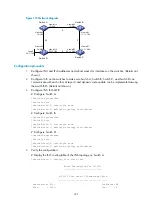
333
Step Command
Remarks
1.
Enter system view.
system-view
N/A
2.
Enter BGP view.
bgp
as-number
N/A
3.
Enter IPv6 address family
view.
ipv6-family
N/A
4.
Configure preference values
for IPv6 BGP external,
internal, and local routes.
preference
{
external-preference
internal-preference
local-preference
|
route-policy
route-policy-name
}
Optional.
The default preference values of
external, internal, and local routes are
255, 255, and 130.
5.
Configure the default local
preference.
default local-preference
value
Optional.
The
value
defaults to 100.
6.
Advertise routes to an IPv6
peer or peer group with the
local router as the next hop.
peer
{
ipv6-group-name
|
ipv6-address
}
next-hop-local
By default, IPv6 BGP specifies the
local router as the next hop for routes
sent to an IPv6 EBGP peer or peer
group, but does not change the next
hop for routes sent to an IPv6 IBGP
peer or peer group.
Configuring the MED attribute
Step Command
Remarks
1.
Enter system view.
system-view
N/A
2.
Enter BGP view.
bgp
as-number
N/A
3.
Enter IPv6 address family
view.
ipv6-family
N/A
4.
Configure a default MED
value.
default med
med-value
Optional.
Defaults to 0.
5.
Enable the comparison of
MED for routes from different
EBGP peers.
compare-different-as-med
Optional.
Not enabled by default.
6.
Enable the comparison of
MED for routes from each AS.
bestroute compare-med
Optional.
Disabled by default.
7.
Enable the comparison of
MED for routes from
confederation peers.
bestroute med-confederation
Optional.
Disabled by default.
Configuring the AS_PATH attribute
Step Command
Remarks
1.
Enter system view.
system-view
N/A
2.
Enter BGP view.
bgp
as-number
N/A
















































